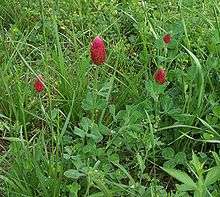Trifolium incarnatum
| Crimson clover | |
|---|---|
 | |
| Crimson clover | |
| Scientific classification | |
| Kingdom: | Plantae |
| (unranked): | Angiosperms |
| (unranked): | Eudicots |
| (unranked): | Rosids |
| Order: | Fabales |
| Family: | Fabaceae |
| Subfamily: | Faboideae |
| Genus: | Trifolium |
| Species: | T. incarnatum |
| Binomial name | |
| Trifolium incarnatum L. | |
Trifolium incarnatum, known as crimson clover[1] or Italian clover, is a species of clover in the family Fabaceae, native to most of Europe. The species name incarnatum means "blood red".
This upright annual herb grows to 20-50 cm tall, unbranched or branched only at the base. The leaves are trifoliate with a long petiole, each leaflet hairy, 8-16 mm across, with a truncated or bilobed apex. The flowers are produced throughout the spring and summer, rich red or crimson, congested on an elongated spike inflorescence 3-5 cm tall and 1.5 cm broad; the individual flowers are up to 10-13 mm long and have five petals. The banner of each flower does not sit upright, but folds forward.
Cultivation and uses

Crimson clover is widely grown as a protein-rich forage crop for cattle and other livestock. It can typically be found in forest margins, fields and roadsides.
It is sown as quickly as possible after the removal of a grain crop at the rate of 20-22 kg/ha. It is found to succeed better when only the surface of the soil is stirred by the scarifier and harrow than when a plowing is given. It grows rapidly in spring, and yields an abundant crop of green food, particularly palatable to livestock. It is also suitable for making into hay. Only one cutting, however, can be obtained, as it does not shoot again after being mown.
In Great Britain it is most valuable in the south, though less successful in northern regions.
It has been introduced into the United States, originally as forage for cattle. It is often used for roadside erosion control, as well as beautification; it tends, however, to eliminate all other desirable spring and early-summer species of native vegetation in the area where it is planted.
References and external links
- ↑ "Trifolium incarnatum". Natural Resources Conservation Service PLANTS Database. USDA. Retrieved 15 December 2015.
- Flora Europaea: Trifolium incarnatum
- Ecoflora: Trifolium incarnatum
- FAO factsheet: Trifolium incarnatum
- Ajilvsgi, Geyata. (2003). Wildflowers of Texas. Shearer Publishing, Fredericksburg, Texas (USA). ISBN 0-940672-73-1.
- Robert W. Freckmann Herbarium, University of Wisconsin Page with several photos.
- Ultrastructural details seen on the surface of a "crimson clover", Trifolium incarnatum flower petal.
| Wikimedia Commons has media related to Trifolium incarnatum. |